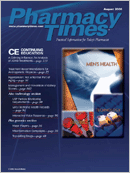Publication
Article
Pharmacy Times
DIABETES WATCH
Key Changes May Curb Deaths
Major changes are necessary to improve individuals' health and control the approaching diabetes epidemic, stressed Robert A. Rizza, MD, president of medicine and science at the American Diabetes Association (ADA). He said, unless action is taken, diabetes will be responsible for 35 million heart attacks, 13 million strokes, 6 million cases of renal failure, 8 million cases of blindness or eye surgery, 2 million amputations, and 62 million deaths in the next 30 years. Although a cure for diabetes is the end goal and would save the United States almost $6.6 trillion in the next 30 years, Dr. Rizza said the achievement is not within reach. He said making sure patients receive optimal care for the disease should be the focus until a cure is found.
Keeping this standard of care entails that every patient with diabetes would need a hemoglobin A1C <7%, a blood pressure reading of <130/80 mm Hg, low-density lipoprotein cholesterol readings of <100 mg/dL, and a high-density lipoprotein cholesterol reading of >40 mg/dL for men or >50 mg/dL for women. Triglycerides should be <150 mg/dL, and body mass index should be <25. The ADA also suggested that each patient with diabetes take a baby aspirin daily to help prevent stroke and not smoke.
Cost Is a Factor in Prevention Program
Although individuals at high risk for developing type 2 diabetes want to lower their odds, few are willing to incur the cost for a risk-reduction program, according to an Internet survey. The participants (582 individuals) were aged 45 years and older. Two thirds were obese and all were at high risk for developing the disease. The hypothetical programs described to study participants included 7 different attributes: diet, exercise, counseling, medication, weight loss goals, risk reduction, and program costs.
The researchers found that overall participants preferred programs that included flexible diets, exercise requirements, counseling, and medication. The participants said they would pay $63 per month over a 3-year period to participate in a program that included the features they favored, but they would be willing to pay only $42 over 3 years for a program similar to the Diabetes Prevention Program, which mainly involves diet and exercise. Furthermore, the researchers noted in Diabetes Care (June 2006), that individuals who believed they were at greater risk for diabetes were willing to spend more money, compared with individuals who felt they were at low risk.
Prediabetes Will Strike Half of US Population
New studies indicated that early symptoms of diabetes and heart disease must be treated aggressively. These symptoms happen in "metabolic syndrome" ?an aggregate of risk factors such as obesity, high cholesterol, and other symptoms.
Researchers examined interviews held as part of an annual national health survey. Of the 3000 healthy respondents, 28% had prediabetes, defined as fasting blood glucose levels between 100 mg/dL and 125 mg/dL, according to Desmond Williams, MD, a diabetes expert at the Centers for Disease Control and Prevention. "We found that people with prediabetes clearly have an excess of cardiovascular risk factors."
A second study, which focused on severely ill patients admitted to intensive care units (ICUs), found that patients without diabetes but with high blood sugar who also had a heart attack, stroke, or chest pain were more likely to die, compared with other patients with the same conditions. Mercedes Falciglia, MD, and her team defined hyperglycemia as blood sugar levels of 111 mg/dL or higher. The condition raised the risk of heart attack death by up to 5 times, and the chance of death from stroke as much as 15-fold. "All patients should have their blood glucose levels monitored when they are admitted to an intensive care unit because hyperglycemia occurs in one third of ICU patients," said Dr. Falciglia. (The findings were recently presented at an American Diabetes Association meeting.)
Type 2 Diabetes Rate Doubles in 30 Years
The dramatic increase in obesity over the past 30 years may be responsible for the growing rate of type 2 diabetes during the same period. Reporting in Circulation (June 19, 2006), the researchers found that type 2 diabetes among middle-aged Americans has doubled over the past 3 decades. The findings were based on data from 3104 men and women, aged 40 to 55, who participated in the Framingham Offspring study. All of the participants were diabetes-free at the beginning of the study, and they underwent routine physical examinations during the 1970s, 1980s, and 1990s.
The researchers discovered that the chances of developing type 2 diabetes rose by 40% from the 1970s to the 1980s and doubled between the 1970s and 1990s. The findings indicated that among women there was an 84% increase in the 1990s, compared with the 1970s. In men, the frequency more than doubled in the 1990s, compared with the 1970s.







